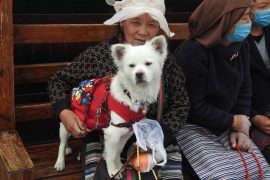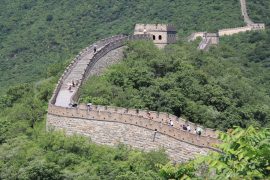IT’S slightly unnerving to be purposefully slicing chicken breast under the beady eye of a large, magnificently plumed cockerel. Judging by his arrogant strut he’s clearly confident that he’s safe from becoming the main ingredient in Tom Kha Gai (chicken in coconut milk soup with lemongrass and galangal). Indeed, he rules the roost at AmitaCookingSchool, which is based in an elegant teak house set in a lush garden in a quiet Bangkok suburb.
The house is part of a large compound  that has been in the family of owner and head chef Tam Piyawadi Jantrupon for three generations. It’s tucked away down one of the canals branching off from the Chao PhrayaRiver, which snakes its way through central Bangkok, a haven from the city’s frenetic pace.
that has been in the family of owner and head chef Tam Piyawadi Jantrupon for three generations. It’s tucked away down one of the canals branching off from the Chao PhrayaRiver, which snakes its way through central Bangkok, a haven from the city’s frenetic pace.
We are collected from our hotel and driven through a web of side streets to the jetty where we board a spacious timber launch. It immediately pushes off into the busy waterway, moving quickly past historic buildings such as the Royal GrandPalace and the Temple of Dawn. After about 20 minutes we turn into one of the narrow canals lined on both sides with timber houses, vivid flowers and lush trees.
People on balconies wave as we pass and we count water dragons as they laze on hot stones or hurriedly swim out of the way. To see three is lucky, the captain says – adding, when we have chalked up our trio, seven is luckier. It is Tam who greets us warmly on arrival and ushers us to the outside dining area, placing a cool drink on the white tablecloth. It’s very welcome. Although it is still relatively early, the cloying wet heat of a Bangkok summer day is already embracing us.
With the cockerel at her side, Tam guides us through the gardens where she grows as many herbs and spices as she can,  explaining the merits of each plant as she walks. There’s lots of pinching, sniffing and tasting. Anything not grown by her is brought in fresh each day as required. We are, she explains, going to cook four dishes, including the Tom Kha Gai. There is Phat Thai, the classic dish of stir-fried soft rice noodles with prawns and tamarind sauce, Gai Phat Met Ma Muang Hummaphan, stir-fried chicken with cashew nuts, and Tab Tim Krob, water chestnuts in syrup with cold coconut milk.
explaining the merits of each plant as she walks. There’s lots of pinching, sniffing and tasting. Anything not grown by her is brought in fresh each day as required. We are, she explains, going to cook four dishes, including the Tom Kha Gai. There is Phat Thai, the classic dish of stir-fried soft rice noodles with prawns and tamarind sauce, Gai Phat Met Ma Muang Hummaphan, stir-fried chicken with cashew nuts, and Tab Tim Krob, water chestnuts in syrup with cold coconut milk.
The menu is different each day but Tam is flexible, making changes to take into account people’s preferences  and allergies if notified in advance. “We are open six days a week,” she says. “Or seven if that’s the only day someone can come,” she adds with a smile. “I want you to have fun, to enjoy things.”
and allergies if notified in advance. “We are open six days a week,” she says. “Or seven if that’s the only day someone can come,” she adds with a smile. “I want you to have fun, to enjoy things.”
Kitted out with large white aprons we head to the custom-designed cooking area. The ingredients for the first dish have been laid out in small bowls on the main preparation area by Tam’s support team.  Talking through each step and occasionally stopping to show everyone exactly what she means, Tam creates her dishes, filling the air with exotic aromas. Finally, it is our turn. Everyone has an individual marble-topped table, stove and implements. Hidden hands have again done all the hard yakka and we have our own little tray of ingredients.
Talking through each step and occasionally stopping to show everyone exactly what she means, Tam creates her dishes, filling the air with exotic aromas. Finally, it is our turn. Everyone has an individual marble-topped table, stove and implements. Hidden hands have again done all the hard yakka and we have our own little tray of ingredients.
Tam is an enthusiastic teacher. There’s a lot of laughter, encouragement and praise. She grabs cameras to record the moments adding a garnish to one dish so it looks “perfect”. The finale is a wonderful banquet, cooked by us, which has been elegantly laid out in the garden. We compare our efforts and are generally impressed by our prowess. Tam is clearly happy at our pleasure and hands us colourful cooking cards with the recipes of each of our  dishes.
dishes.
Bangkok has a growing number of cooking schools catering for the whole spectrum of skills from the amateur to professionals. Some of the hotels also run courses, for example the venerable Oriental and the Metropolitan, home to Nahm, the award-winning Thai restaurant run by Aussie David Thompson.
The amount of hands-on work you do varies from school to school and it is worth checking that out with the owners before signing up. Similarly, check whether you are picked up or have to make your own way there. Prices also vary. At 3000 baht ($A98), Amita is one of the more expensive ones, but the whole experience was more than worth it. Not only was it a wonderful day but I still pull out those recipe cards to re-create a tangible holiday memory. And it still tastes delicious.





Comments are closed.